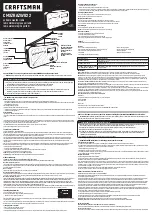
controlled clock) frequency signal. “
” flashes on the LCD. The signal “
”
appears permanently when the signal is received successfully.
•
The clock automatically scans the time signal at 3.00 a.m. everyday to maintain
accurate timing. For failed reception, scanning stops (“
” on the LCD disappear)
and repeats again at 4.00 a.m. 5.00 a.m. and 6.00 a.m.
•
The clock manually scans the time signal by holding “
-
(
°
C/
°
F)” button (B7) for
3 seconds. Press “
-
(
°
C/
°
F)” button (B7) again for 3 seconds to stop scanning
when receiving DCF signal.
•
Time can be set manually as well (see 1.5.1 Clock setting).
1.5 How to operate
Important:
•
Buttons will not function while scanning DCF or outdoor temperature signal
unless they are well received or stopped manually.
•
During operation, all successful settings will be confirmed by an acoustical signal.
•
The instrument will quit the setting mode, if there is no button used within 5
seconds period.
•
Holding “+” or “-” buttons, you will enter fast mode.
1.5.1 Manual Time Setting:
•
Hold “ MODE” button for 2 seconds. Press “+” or “-” buttons to adjust Hours.
Using “ MODE” button you can switch to setting minutes, seconds, year,
month/day sequence, month, day, time zone, day-of-week language.
•
In “month/day sequence” the two different date displays can be selected:
Month/date (American version) or date/month (European version).
•
The time zone is used for the countries where the DCF signal can be received but
the time zone is different from the German time (e.g. 1=one hour later).
•
Languages and their selected abbreviations for each day of the week are shown in
the following table:
Language
Sunday
Monday Tuesday Wednesday Thursday Friday Saturday
German, GE
SO
MO
DI
MI
DO
FR
SA
English, EN
SU
MO
TU
WE
TH
FR
SA
Russian, RU
BC
NH
BT
CP
HT
NT
CY
Denmark, DA
SO
MA
TI
ON
TO
FR
LO




























